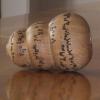Articles
2012 Medal count: how do our predictions stack up?In our article Mapping the medals we came up with our very own prediction of the 2012 Olympic medal counts for the top 20 countries! This interactive map tells you how our predictions stack up: click on a country to see its actual medal count, our prediction and the results from 2008.
String Theory, Duality and Art: how the Higgs boson and Turner Prize collide On the face of it, an artist and a theoretical physicist might seem an unlikely pairing. But Turner Prize-winning sculptor Grenville Davey and string theorist David Berman's collaboration is producing beautiful, thought-provoking work inspired by the fundamental structure of the Universe. Julia Hawkins interviewed them to find out more about how the Higgs boson and T-duality are giving rise to art.
Building bridges from mathematics to the City
Many people's impression of mathematics is that it is an ancient edifice built on centuries of research. However, modern quantitative finance, an area of mathematics with such a great impact on all our lives, is just a few decades old. The Isaac Newton Institute quickly recognised its importance and has already run two seminal programmes, in 1995 and 2005, supporting research in the field of mathematical finance.
Strings, particles and the early UniverseThe Strong Fields, Integrability and Strings
programme, which took place at the Isaac
Newton Institute in 2007, explored an area that
would have been close to Isaac Newton's heart:
how to unify Einstein's theory of gravity, a
continuation of Newton's own work on
gravitation, with quantum field theory, which
describes the atomic and sub-atomic world, but
cannot account for the force of gravity.
Taming water wavesFew things in nature are as dramatic, and potentially dangerous, as ocean waves. The impact they have on our daily lives extends from shipping to the role they play in driving the global climate. From a theoretical viewpoint water waves pose rich challenges: solutions to the equations that describe fluid motion are elusive, and whether they even exist in the most general case is one of the hardest unanswered questions in mathematics.
Renewable energy and telecommunicationsWhen the mathematician AK Erlang first used probability theory to model telephone networks in the early twentieth century he could hardly have imagined that the science he founded would one day help solve a most pressing global
problem: how to wean ourselves off fossil fuels and switch to renewable energy sources.
The shape of things to comeProgress in pure mathematics has its own tempo. Major questions may remain open for decades, even centuries, and once an answer has been found, it can take a collaborative effort of many mathematicians in the field to check
that it is correct. The New Contexts for Stable Homotopy Theory programme, held at the Institute in 2002, is a prime example of how its research programmes can benefit researchers and its lead to landmark results.
From neurobiology to online gamingArtificial neural networks grew out of researchers' attempts to mimick the human brain. In 1997 the Isaac Newton Institute hosted a landmark research programme in the area. Today, neural networks are able to learn how to perform complex tasks and are crucial in many areas of life, from medicine to the Xbox.
Secret symmetry and the Higgs boson (Part II)
In the first part of this article we explored Landau's theory of phase transitions in materials such as magnets. We now go on to see how this theory formed the basis of the Higgs mechanism, which postulates the existence of the mysterious Higgs boson and explains how the particles that make up our Universe came to have mass.
Secret symmetry and the Higgs boson (Part I)It's official: the notorious Higgs boson has been discovered at the Large Hadron Collider at CERN. The Higgs is a subatomic particle whose existence was predicted by theoretical physics. Also termed the god particle, the Higgs boson is said to have given other particles their mass. But how did it do that? In this two-part article we explore the so-called Higgs mechanism, starting with the humble bar magnet and ending with a dramatic transformation of the early Universe.
Phantasms of infinityInfinity is a pain. Its paradoxes easily ensnare the unsuspecting
reasoner. So over the centuries,
mathematicians have carefully constructed
bulwarks against its predations.
But now cosmologists have developed
theories that put them squarely outside
the mathematicians' "green zone" of
safety.
Taming infinityQuantum mechanics and general relativity are incompatible — and this has led to a decades-long search for a theory of quantum gravity that could combine the two. But the particle physicist Richard Woodard thinks that the mismatch between the two could be nothing more than an illusion, created by the complicated maths techniques used in attempts to unite them.
